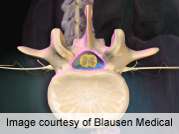Use of intraoperative blood salvage (cell saver) is not cost-effective for adult patients undergoing single-level posterior lumbar decompression and fusion surgery, according to research published online Oct. 5 in Spine.
(HealthDay)—Use of intraoperative blood salvage (cell saver) is not cost-effective for adult patients undergoing single-level posterior lumbar decompression and fusion (PLDF) surgery, according to research published online Oct. 5 in Spine.
Chelsea E. Canan, M.P.H., from the Norton Leatherman Spine Center in Louisville, Ky., and colleagues retrospectively reviewed medical records from 180 randomly selected adult patients who underwent a single-level PLDF. Costs were calculated for allogeneic blood transfusion, setting up the cell saver recovery system, and infusing autologous blood from cell saver. Effectiveness was measured by allogeneic blood transfusions averted and quality-adjusted life-years (QALYs).
The researchers found that the transfusion rate decreased from 40.0 to 38.7 percent with the cell saver approach, with an incremental cost-effectiveness ratio (ICER) of $55,538 per allogeneic transfusion averted. The cell saver approach was considered not cost-effective, with an ICER of $5,555,380 per QALY gained—well above the cost-effectiveness threshold of $100,000 per QALY gained.
"The use of cell saver during a single-level PLDF does not significantly reduce the need for allogeneic blood transfusion and is not cost-effective," Canan and colleagues conclude. "Further studies are needed to evaluate the necessity for cell saver among other types of spinal surgery."
More information:
Abstract
Full Text (subscription or payment may be required)
Journal information: Spine
Copyright © 2012 HealthDay. All rights reserved.



















